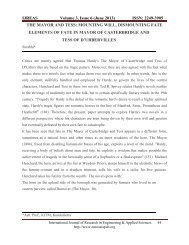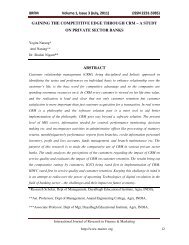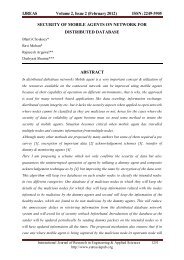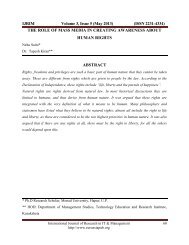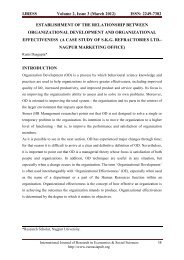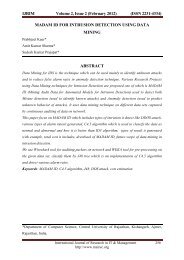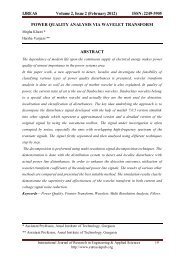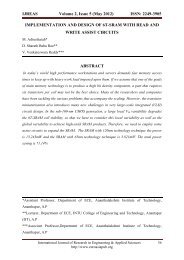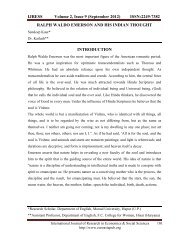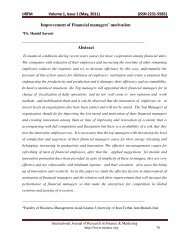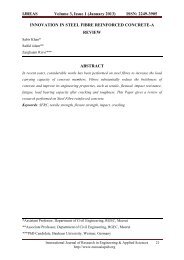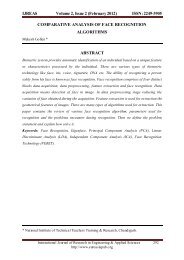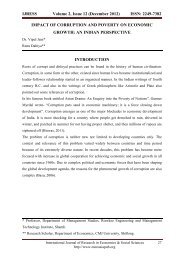shakespeare's sonnets - a critical analysis - Euroasiapub.org
shakespeare's sonnets - a critical analysis - Euroasiapub.org
shakespeare's sonnets - a critical analysis - Euroasiapub.org
You also want an ePaper? Increase the reach of your titles
YUMPU automatically turns print PDFs into web optimized ePapers that Google loves.
IJRESS Volume 2, Issue 9 (September 2012) ISSN: 2249-7382<br />
What kind of love does 'this' in fact give to 'thee' We know nothing of the beloved’s form or<br />
height or hair or eyes or bearing, nothing of her character or mind, nothing of her at all, really.<br />
This 'love poem' is actually written not in praise of the beloved, as it seems, but in praise of<br />
itself. Death shall not brag, says the poet; the poet shall brag. This famous sonnet is on this view<br />
one long exercise in self-glorification, not a love poem at all; surely not suitable for earnest<br />
recitation at a wedding or anniversary party, or in a Valentine.<br />
SONNET 30<br />
Shakespeare's “Sonnet 30” is a Shakespearean sonnet, composed of three quatrains and<br />
a couplet. In the couplet, the writer tends to take a different track compared to the rest of the<br />
sonnet. The change in this one is signaled by a single word-”But.” This sonnet, like most is<br />
written in iambic pentameter.<br />
The entire three quatrains are devoted to showing us his grief over his “fair lord.” Shakespeare<br />
uses language in this sonnet to draw the reader in to the emotional pain portrayed with lines like,<br />
“I summon up” and “Then I can.” These lines help draw the reader to his sad feelings about his<br />
friend balanced by the realization that he had such a friend. A courtroom motif is used in the first<br />
part with “session,” “summon up,” and “cancelled.” This motif is used to stress his dependence<br />
financially on his fair lord. He also uses the words “expense,” “grievances,” “account,” “paid,”<br />
and “losses” to further emphasize that fiscal relationship. The speaker realizes in the poem that<br />
the fair lord has credits on his side. In other words, the speaker can never repay all that his fair<br />
lord has given him.<br />
Shakespeare also uses both repetition and internal rhyme to convey his message. Alliteration is<br />
shown in “sigh,” “sight,” and “sought,” “things,' and “past” as well as in the phrase “sessions of<br />
sweet silent thought.” Internal rhyme is used in “foregone,” “fore bemoaned,” “before” and<br />
“restored.” He uses assonance as well in the use of a short e in phrases like “sessions” and<br />
“remembrance.” Shakespeare actually cleverly uses this sort of assonance to unify the poem's<br />
beginning and end. “When” begins the poem, and “end” ends the poem.<br />
Shakespeare, a master poet, once again writes a beautifully complicated yet simply <strong>sonnets</strong>, tying<br />
it all together with elaborate assonance. Alliteration and internal rhyme also help to convey his<br />
intense grief in Sonnet 30.<br />
International Journal of Research in Economics & Social Sciences 70<br />
http://www.euroasiapub.<strong>org</strong>



